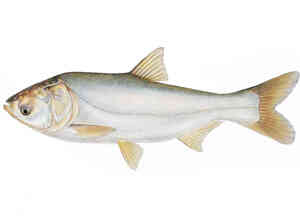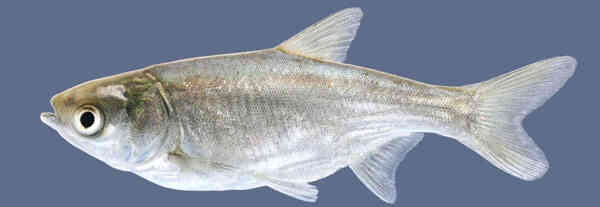
Name Hypophthalmichthys molitrix
Alias Hypophthalmichthys molitrix,Silvercarp、Chinese Schemer,Silver carp, silver carp, jumping silver carp, silver carp, whale, white bream, white-footed silver carp, foreign fathead, white leaf, white fath
Family Cypriniformes Cyprinidae S.carp
Silver carp generally inhabit the upper layer of the main stream of rivers and their affiliated water bodies. They are lively and good at jumping. The newly hatched fry drift with the water; the young fish can actively swim into the river bay or lake to feed. The spawning group begins to gather in mid-April every year and migrate upstream to the spawning grounds to reproduce. After spawning, the adult fish often enter the lakes with abundant bait to feed. In winter, the lake water drops, and most of the adults hibernate in the deep riverbed, while most of the larvae stay in the deep water of lakes and other affiliated water bodies to hibernate. They are not very active in winter. They mainly feed on phytoplankton, but they still feed on zooplankton in the fry stage. They are a typical planktonic fish. The fry feed on zooplankton, such as rotifers and nauplii of cladocerans and copepods, and may also eat micro-particle feed in artificially fed soy milk. After the juvenile stage, silver carp mainly feeds on phytoplankton (algae) by filtering, and also feeds on zooplankton, detritus and bacterial aggregates. They like to grow fat in the still water bodies along the river, and return to the riverbed of the main stream or hibernate in the deep lakes in winter.

Originated from East Asia. It is widely distributed in China, from Hainan Island, Yuanjiang River and Pearl River in the south to the Heilongjiang River Basin in the east of my country. All rivers, lakes and reservoirs are distributed. In the Inner Mongolia Autonomous Region, it is naturally distributed in the main stream and tributaries of the Nenjiang River system: Nuomin River, Ali River, Gan River (Oroqen Autonomous Banner, Molidawa Daur Autonomous Banner), and in the Chuoer River, it is mainly concentrated in the lower reaches (Zhalaite Banner).
Economic and edible: Silver carp is one of the four major freshwater carps in China (green carp, grass carp, bighead carp, and bighead carp). Artificial breeding has been widely implemented in various parts of China, and it occupies an important position in the production of freshwater fish. It has been introduced for breeding in many areas outside China. It not only has high economic value, but also has ecological value in purifying water quality. It is the main object of breeding in reservoirs, lakes, and ponds. The fish meat is tender and delicious, and it is a common edible fish in the market.
Medicinal uses: ① Meat: warms the middle and replenishes qi, promotes diuresis; used to treat chronic illness, physical weakness, and edema. ② Head: used to treat dizziness and fatigue.
The bile of silver carp is poisonous. Cases of poisoning due to swallowing silver carp bile have occurred in various places. The symptoms of poisoning are the same as those of grass carp, and severe cases can lead to death. Case: A person swallowed a cooked silver carp gallbladder weighing 1 kg and died of toxic myocarditis, pulmonary edema, toxic hepatitis and acute renal failure 2 days later. Its toxin component is sodium cyprinid sulfate, which is a water-soluble bile salt. A mouse weighing 20 grams was used as an experimental animal and gavaged with 0.3 ml of bile. It began to die of poisoning 12 hours later, proving that bile is toxic. There is no specific treatment. Swallowing silver carp gallbladder should be strictly prohibited to avoid poisoning.